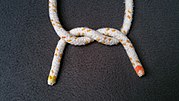Overhand knot
| Overhand knot | |
|---|---|

|
|
| Type | stopper |
| application | |
| Ashley No. | 46, 514, 515, 519 |
| strength | approx. 45% |
| Synonyms | Thumb knot |
| English | Overhand knot |
| List of nodes | |
The overhand knot is the simplest stopper knot . It is tied by winding the end around its own standing part .
application
The knot strength of the overhand knot is around 50%. It is extremely difficult to solve after stress. When unencumbered, it tends to open up on its own.
It usually serves as a stopper knot , for example to prevent the end of a sewing thread from slipping through the fabric.
With an overhand knot, a bag or sack can be closed without a binding agent if it is not completely filled and there is still enough material ("neck") left to knot.
In seafaring, it served as a barrel strike to lift barrels.
The overhand knot is also part of many other knots such as the lace knot and connecting knot like the double spar stitch .
Demarcation
Frequently, the overhand knot with which it is half a knot and half a beat confused. These three nodes are very similar in structure, but have clearly different uses.
- differences
The overhand knot is tied with one end of the rope around its own standing part. He's a stopper knot .
The half knot is often tied around an object with two rope ends. It is a loose connecting and tying knot that is used to tie up packages, shoe bows and the like. In the vast majority of cases, it does not appear as an independent knot.
The half pitch is tied by first tying one end of the rope around an object and only then around your own standing part. It is used to secure the end of the rope.
Modifications
- If the free end of the overhand knot is passed through the eye again, a double or double overhand knot is created .
- If you put several overhand knots one after the other around a pole, you get the Marlschlag .
- If you put an overhand knot on slip (i.e. you tie it in such a way that a loop is created with which the knot can be opened quickly), the slipstek is created .
- If you put two ends of the rope together and make an overhand knot with both, a sack stitch is created .
- If you twist your eye half a turn with the overhand knot, you get an eight knot .
- If you put an overhand knot in a ribbon and follow it with a second ribbon in exactly the opposite direction, the ribbon loop knot is created as a connection between two ribbons.
- If you put an overhand knot around a second rope and use it to make an overhand knot around the first rope, a spar stitch (fisherman's knot) is created.
Alternatives
The double overhand knot is a thicker stopper knot than the single overhand knot.
Seafarers and climbers use the figure of eight knots more often as stoppers . The knot is thicker and lies in the middle of the line. The Ashley stopper knot makes an even thicker stopper knot .
Individual evidence
- ↑ Clifford Ashley: Ashley Book of Knots . Number 514, p. 94 .
- ↑ Geoffrey Budworth: The best knots for everyday life, leisure and sport . Bassermann, Munich 2005, ISBN 978-3-8094-1793-4 (Original title: The Really Useful Knot Book .).
- ↑ Clifford Ashley: Ashley Book of Knots . Number 46-48, pp. 24 .




